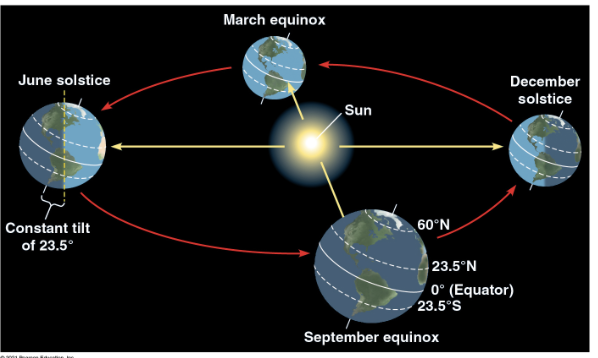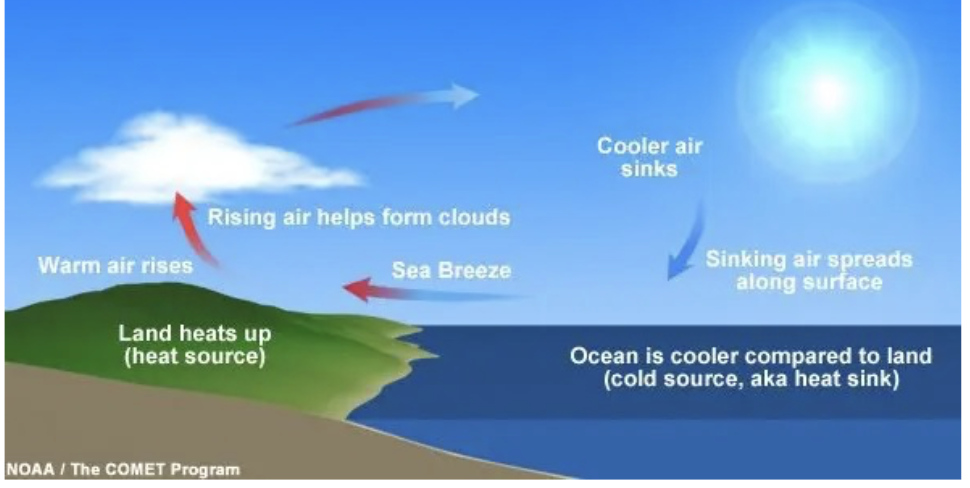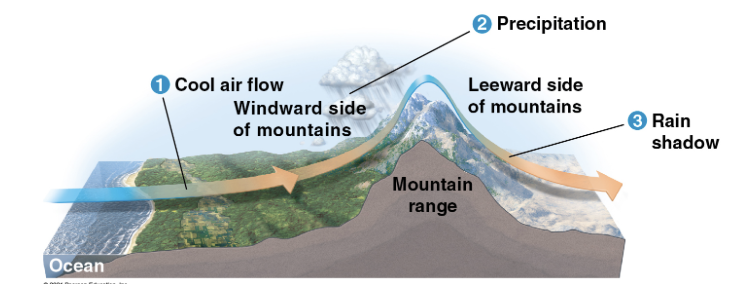Ecology Study Set - Biology Exam 4
1/100
There's no tags or description
Looks like no tags are added yet.
Name | Mastery | Learn | Test | Matching | Spaced |
|---|
No study sessions yet.
101 Terms
Ecology
The scientific study between organisms and their environments
Population
A group of the same species living in a defined area
Community
A group of differing populations living in a specified area
Ecosystem
The community of organisms in an area and the physical factors they interact with
Landscape Ecology
How spatial patterns and ecological processes interact across different scales, shaping ecosystems, biodiversity, and environmental dynamics
Biosphere
The sum of all the planet’s ecosystems and landscapes
Climate
The long term (with a minimum of 30 years of study) prevailing weather conditions at a given place
Global Air Circulation
Hot air rises and cool air sinks - at the equator, air and water masses are heated, sent towards the poles, cooled, and circulated back down
Reasoning for Air Flow Towards Poles
Since the planet is roughly spherical, different areas spin at different speeds. The equator, which has the largest circumference, moves the fastest, whereas regions closer to the poles move more slowly. This difference in rotational speed affects how air moves across the planet. As a result, air is deflected away from the equator and generally flows toward the north and south poles, shaping our weather and climate systems
Seasonality
Depicted by the earth’s tilt on its axis and movement around the sun (when it is summer in the northern hemisphere, it is winter in the southern hemisphere)

Cause of Wind
Water and air obtain different specific heat temperatures - during the day the air is warmer than water. This causes the air over the land to expand and rise. At the same time, the heavier/cooler air that rested above the hot air sinks back down (rapidly) and creates breezes

The Rain Shadow Effect
Moisture filled air is forced up over a mountain from the ocean. It is cooled and releases moisture - producing rain fall on the windward side. The air eventually falls back down on the leeward side

Vegetation Climate
Plants transpire and return water to the atmosphere - this act lowers temperatures and can induce precipitation
Abiotic Factors
Small scale differences in temperature, precipitation, sunlight, and wind
Biotic Factors
Living factors, or other organisms that are components of an individual’s environment
Microclimates
Localized patterns in landscape change via shade casting, alterations in soil evaporation, or changing wind patterns
Terrestrial Biomes
Major life zones characterized by vegetation (determining average temperature and precipitation of an area can lead to identification of this)
Tropical Forest
Lush vegetation, little variation in temperature (around 25 degrees C), consistent rainfall, and incredible biodiversity of plants and animals
Desert
Low and highly variable precipitation, low and scattered vegetation adapted to arid conditions (fluctuates between 10 - 25 degrees C)
Savanna
Long dry seasons followed by seasonal rainfall, scattered trees among grasses, larger herbivores and many insects
Chaparral
Rainy winters and dry summers, significant plant diversity with a majority of low shrubby plants, and browsing animals are common (like deer)
Temperate Grassland
Seasonal precipitation with dry, cold winters and wet, hot summers, many grasses, periodic drought and fire, large grazing animals, very fertile soils make them prime for agriculture
Northern Coniferous Forest
Largest terrestrial biome on earth locate only within the northern hemisphere - dominated by cone-bearing trees such as spruce, pines, figs, or heavily logged trees
Population Density
Number of individuals per unit area or volume
Population Dispersal
Patterns of spacing of individuals within the population boundary
Major Patterns of Dispersion
Clumped: resource availability and social interaction
Uniform: competition for resources and territoriality
Random: resource abundance and seed dispersal
Population Increase and Decrease Factors
Births and immigration lead to influx, while deaths and immigration lead to deflux - both influenced by competition, resource availability, habitats, etc.
Demographics
The study of vital population statistics and how they vary overtime
Life Tables
Often representing a cohort (a group of individuals of the same age that are followed until they are dead), these summarize survival and reproductive rates of individuals within a specific age group
Survivorship Type I Curve
Represents very little die off at early age - most deaths occur at later ages (ie. elephants and humans)
Survivorship Type II Curve
Obtaining 50/50 chance of either survival or death at any point of one’s life (ie. squirrels)
Survivorship Type III Curve
High mortality rate when individuals are young. Those that do survive will continue to live and see much older ages
Reproductive Rates
Focusing on females given their reproductive output statistics - high output does not guarantee high rates unless conditions for adequate growth and survival prevail
Exponential Growth
When resources are most plentiful and populations increase by a constant proportion at each instant in time
Logistic Growth
Increase in growth with an eventual flattening as the population approaches a point where resources can no longer sustain its growth
Carrying Capacity
The maximum population size that a particular environment can sustain
Density Dependance/Equilibrium Density
All organisms depend on their density given that enough individuals are needed to reproduce, but not to the point where resources are limited
Density Dependent Mechanisms
Competition: as population size increases, competition for resources will as well
Territoriality: trying to maintain dominance over a certain area - can lead to conflict and death
Disease: if transmission rates of disease increase as populations become more crowded, then its effect is dependent
Ecological Footprint
The summary of the aggregated resources required to sustain humans (can be heavily based on overall resource consumption)
Competition
The result of two different species using a resource that limits the survival and reproduction of both individuals
Ecological Niche
Inclusion of all environmental factors that influence growth, survival, and reproduction of a species
Fundamental Niche
The physical abiotic conditions species live under - in the absence of interactions with others
Realized Niche
The portion that occupies interaction amongst other species such as competition, predation, disease, and parasitism
Competitive Exclusion
Two different species occupy identical niches and are competing for the same limiting resource - they cannot coexist indefinitely, and ultimately one species will rule out the other
Resource Partitioning
The differentiation of niches that enables different species to coexist within a community
Exploitation
A species utilizing another species where one benefits and the other is harmed - predation, herbivory, and parasitism (these relationships can drive out certain organisms and lead to influxes of growth in others)
Endoparasites
Parasites that live within their host organisms
Ectoparasites
Parasites that live on the exterior of their hosts
Mutualism
An organismal relationship where both species benefit (mycorhizzal fungi on trees: fungi receive photosynthetic products while the tree gains a more extensive root system for nutrient and water uptake)
Commensalism
An relationship that benefits one of the interacting species, but neither harms nor benefits the other
Species Diversity
The variation of different organisms that make up a community (more diverse communities are more likely to withstand environmental stresses)
Species Richness
Component of species diversity that depicts the number of different species found within a community
Relative Abundance
Component of species diversity that depicts the percentage of individuals belonging to a certain species within a community
Trophic Structure
Describes feeding relationships between organisms in a community (the base of the food chain primary producers: plants and autotrophs)
Primary Consumer
The organisms that injest primary producers
Secondary Consumer
The organisms that injest primary consumers (tertiary and quaternary consumers follow same pattern up the chain)
Foundation Species
Things large in size and high in abundance - trees, desert shrubs, kelp, or coral
Keystone Species
Species that are not in abundance in a community, but their presence improves community structure (cannot be identified until it has been removed from a community and induces drastic changes) - (ie. sea otters being removed from the California coast and sea urchins began to overpopulate)
Ecological Engineers
Significantly alter ecosystems and provide more complex habitat (ie. beavers building damns, and alligator trails/holes serving as refuge for birds and fish)
Disturbance
Any event that changes a community by removing organisms or altering their availability
Ecological Succession
Recovery from a large scale disturbance where the disturbed area is recolonized by a variety of species
Primary Succession
The ecological process where life begins in a barren and uninhabited area
Secondary Succession
The regrowth of an ecosystem following disaster that has not been completely wiped of all existing soil
Genetic Diversity
Genetic variation within a population and between populations
Ecosystem Diversity
Maintaining a variety of ecosystems on earth
Ecosystem Services
The services that natural ecosystems provide to humans
Provisioning
Products obtained from an ecosystem like food, water, or medicines (ie. honey produced by bees)
Regulating
Benefits obtained from the regulation of ecosystems like flood prevention, climate control, and erosion control (ie. mangrove forests with trees that thrive in saline water and soils - prevents coastal erosion and reduces impacts of storm surges)
Supporting
Services necessary for the production of all other ecosystems like nutrient cycling (ie. microorganisms in soil that enhance root growth and nutrient uptake)
Cultural
Non-material benefits obtained from ecosystems like educational, recreational, and spiritual
Nutrient Enrichment
A result of growing more food on land in shorter periods of time. This results in fertilizer run off into local waterways that eventually get dumped in larger bodies of water. Such accumulation depletes oxygen levels in water and makes it impossible to sustain life.
Environmental Toxins
Byproducts of human activity released into the atmosphere, waterways, animals, etc.
Greenhouse Gasses
Gases that can absorb yet also retain and emit solar energy, ultimately leading to an increase in atmospheric temperature
Ozone Layer
A layer of three oxygens that blocks harmful UV radiation from the sun
Ozone Layer Depletion
Caused by a man-made chemical being released into the air called chloroflourocarbon when oxygens bond to the CFC’s instead of each other and halt production
Introduced Species
Humans either accidentally or intentionally transporting species to a new location where they exhibit zero competition for resources and obtain the ability to dismantle resources and prey on native species
Overharvesting
Humans over consuming products leading to both loss of species and harmful waste
Global Change
Alteration in climate conditions, atmospheric chemistry, and ecological conditions that make earth’s capacity to sustain life unattainable
2 Approaches to Conserving Populations
Focus on small populations
Focus on declining populations to prevent them from becoming small
Minimal Viable Population Size
The minimum a population size can be at to sustain its numbers - examine the size of a small population as it begins to ream the effects of the population vortex
Effective Population Size
Examines the breeding potential within a population
Weighing Conflicting Demands
Process used by scientists when examining species to take into account the costs and benefits saving a certain species holds
Biodiversity Hot Spots
Relatively small areas around the globe with rich species diversity (protecting these spots ensures more species are cared for)
Natural Reserves
Islands of biodiversity in overall areas of altered habitat
Zoned Reserves
Extensive regions that are undisturbed surrounded by human activity
Urban Ecology
Looks at organisms and their environment in an urban setting
Aquatic Biomes
Biomes characterized by the amount of light penetration and nutrient availability
Photic Zone
Region of water where light levels are sufficient for photosynthesis
Aphotic Zone
Region of water where light levels are insufficient enough to carry out photosynthesis
Pelagic Zone
Region of water that is not considered near the shoreline (open water)
Benthic Zone
Region compromising the bottom of a body of water - includes sediments
Lakes
Standing bodies of freshwater of varying sizes - may be oligotrophic: oxygen rich and nutrient poor, or eutrophic: oxygen poor and nutrient rich
Wetlands
Flooded with water part of the time, supports plants that are adapted to water-logged soils, acts as biological filters for water run-off, important for flood prevention, one of the most productive biomes on Earth, home to diverse communities of organisms
Streams and Rivers
Moving water of varying velocities, great capacity to carve out the landscape and deposit materials further down river, headwater streams are often narrow with a rocky bottom, as the river progresses it grows in width and the amount of sediment
Estuaries
A transition zone between river and sea, brackish often salty inflow from the ocean, very nutrient-rich (salt marshes are an example), crucial for fish breeding and waterfowl feeding areas
Intertidal Zone
Submerged twice daily by tides, often brutally hot or buffeted by waves, variation in temperature and salinity
Ocean Pelagic Zone
Open ocean zone susceptible to ocean currents, distinct photic and aphotic zones - covers 70% of the Earth's surface
Coral Reefs
Formed from calcium carbonate skeletons of corals, incredibly biodiverse but threatened due to their narrow range of temperature and pH tolerance
Marine benthic Zone
Sea floor with many sessile organisms, typically aphotic
Temperate Broadleaf Forest
Moderate climates and rainfall, dominant species are the deciduous trees, heavily logged and settled but through conservation efforts are returning to their original range